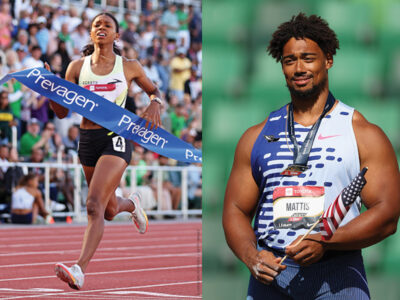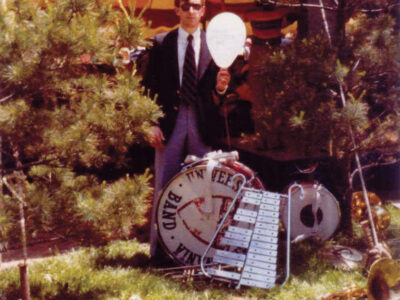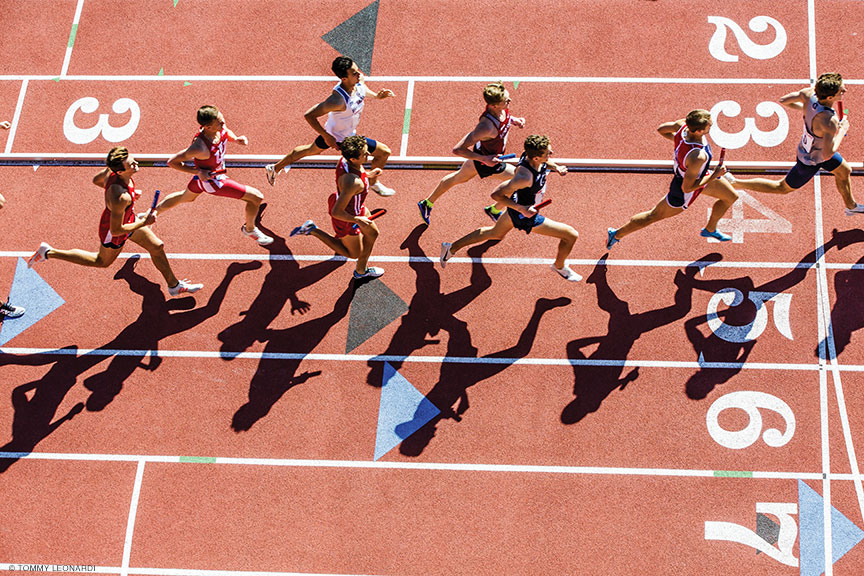
The country’s oldest and largest track meet continues to draw world-class athletes, big crowds, an army of loyal volunteers, and a whole lot of Jamaicans.
BY DAVE ZEITLIN | Photography Tommy Leonardi C’89
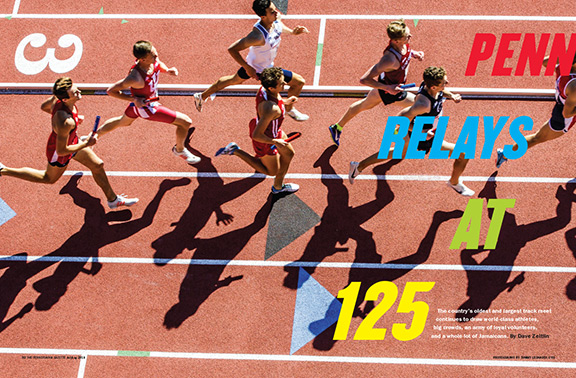
Sixty-one years ago, Kevin Quinn skipped his high school senior prom to come to Franklin Field on the last Saturday in April. He ran in the 4×800-meter relay with three St. Joseph’s Prep classmates. The old track crunched beneath him as he took the baton, running his 800-meter leg in a swift 2 minutes, 5 seconds. It was a good memory, a lasting memory. And for six decades, even as Quinn returned to the famed Penn Relays year after year as Saint Joseph University’s longtime track and field coach, it remained the pinnacle.
Until this year.
Near the end of the first day of the 125th running of the country’s oldest and largest track and field competition, Quinn—now a 78-year-old volunteer assistant coach for Penn—told a quartet of Quakers about his new greatest Penn Relays moment. “After 78 years, and 61 here,” he said softly, “I got to stand on the platform—and that’s because of you guys.” Melissa Tanaka, one of the four Penn runners, fought back tears. Just moments earlier, she had teamed with Nia Akins, Uchechi Nwogwugwu, and Maddie Villalba to lead Penn to a first-place finish in the women’s distance medley relay (DMR) Championship of America—one of the meet’s marquee college events.
On the Franklin Field infield after the victory, Penn track and field director Steve Dolan—just done hollering at Villalba, who ran the mile anchor leg, to “stay in the moment” while the public address announcer exclaimed, “No Ivy League women’s team has ever won a Championship of America!”—hugged the four runners. Tony Tenisci, who retired in 2016 after 30 years coaching track at Penn, hugged just about everybody in sight. Dave Johnson, longtime director of the Penn Relays, cried out, “Get ’em around! All the way around!” Tanaka, Akins, Nwogwugwu, and Villalba then enjoyed a victory lap, all the way around, ending near the corner of Franklin Field where classmates had chanted “U-PENN” throughout the race.
For much of the history of the Penn Relays, Penn has been more a host than a true threat on the national stage. But even after 125 years, thanks to four of the more than 12,000 competitors on hand over the course of three days, the iconic meet showed that it’s still capable of staging historic surprises. “There are breakthroughs every year,” Johnson says. “You just don’t know where and when they’re going to happen.”
The breakthrough for an Ivy League women’s team to win a championship took more than 40 years, since women first got their own day of racing at Penn Relays in 1978. The championship drought lasted about as long for the Penn men before Thomas Awad C’16 led the Quakers to a dramatic 4xmile win in 2016. “It was always our dream to think about winning a DMR—the same thing for the women,” says Jeff Wiseman C’18, a former Penn track standout who now works in the University’s athletics department. “To see them win, so convincingly, with all of the student-athletes and fans cheering them on, it’s hard not to get emotional.”
Few were as emotional as Quinn, who got to stand on the winners’ platform and take a photo with the Penn athletes after they accepted their “wheel”—the plaque, designed in 1925, depicting Ben Franklin holding a laurel sprig and greeting four runners. “It was very moving,” Quinn says. “For a Philadelphia kid who ran here in high school to stand on that platform—it was just an amazing feeling.”
And the chance to play even a small part in it—“My contribution is minimal at best,” he says—is why he, like so many others, keeps coming back to Franklin Field every April. From veteran coaches like Quinn to volunteer officials to media members to competitors ranging in age from 10 to 100, people come to the meet for different reasons. But for all of them, the Penn Relays has become a fixture on the calendar—equal parts track meet, carnival, and family reunion.
“It really is the embodiment of athletics,” Quinn says. “It gives track a lot of attention, which it doesn’t usually get. For one weekend, track is important.”
The Moments
Renaldo Nehemiah couldn’t understand where everyone went.
Needing some time to recover after completing the anchor leg in the 1979 college 4×400 relay—the final race of the day—the University of Maryland star retreated to a Franklin Field locker room. “I thought I was actually going to have a heart attack, I was hurting so badly,” he recalls. “I remember telling my coach I’m never running another 400 again.”
And he didn’t, instead becoming a record-setting hurdler and, for a few years, an NFL wide receiver. He also didn’t get to enjoy much proper recognition at the time, since when he returned to the track from the locker room, most of the people in the stadium had already filed out. Yet Johnson still calls Nehemiah’s performance the single greatest moment he’s ever witnessed at the Penn Relays—“and I think that’s the case for most people my age, give or take 10 or 20 years,” adds the Penn Relays Director, who first attended the meet as a high school junior.
On a raw, drizzly day 40 years ago, Nehemiah “did something I’ve never seen another quarter-miler do,” Johnson says. “He looked like he popped a gear, like he was just coming out of the starting blocks.” He made up a 20-meter deficit in the last lap to lead Maryland to its third win of the day, following exciting victories in the shuttle hurdle and 4×200 relays. It surprised even Nehemiah, who was trailing by so much he simply tried to give it “a gallant try” so at least the fans would be sympathetic. “But when I got around the third turn and heard the crescendo of screams, it kind of propelled me,” he says. That’s a familiar theme at the Penn Relays, where crowds topping 40,000 have a way of driving wild comebacks and plucky underdogs.
“Of all the accomplishments I had, that seems to be the most compelling one that people witnessed,” adds Nehemiah, who returned to this year’s 125th anniversary running as an honorary carnival referee. “People I don’t even know come up to me and say it was the greatest thing they’ve ever seen in their life … The afterglow has sustained itself for more than 40 years.”
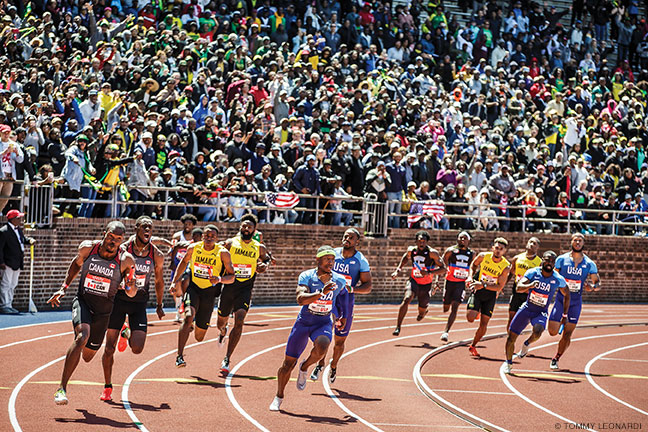
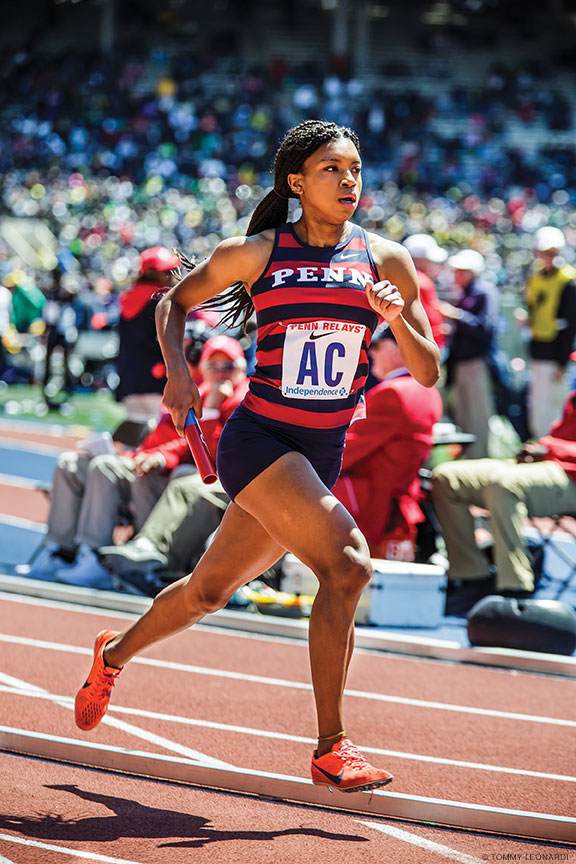
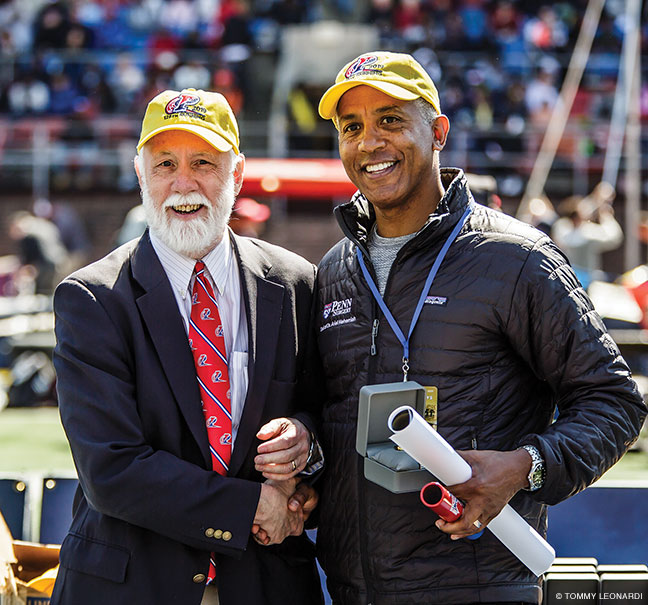
Johnson has seen plenty of other memorable performances during the 51 Penn Relays he’s attended. At his first, in 1968, he learned to never leave early when Villanova won its fifth relay championship with the meet’s first sub-44-second quarter mile—just as he was walking away from the stadium. A history buff described by colleagues as a “walking encyclopedia” of track and field, Johnson also wishes he had been around for some of the more iconic moments of the Relays’ first three-quarters of a century. “I would have loved to have seen the race in 1914, in a driving rain, on a muddy track, with Oxford and Penn running a 4xmile relay at the end of the day,” he says. Oxford, loaded with a world record holder and an Olympic champion, won narrowly on the final straightaway—but Penn, “by any reckoning, shouldn’t have even been that close to them,” Johnson says.
Aside from the home team capturing the underdog spirit, that 1914 race was significant for another reason, as it marked the first time the Penn Relays went international—beginning a long and fruitful tradition that has made the meet what it is today. That may have been hard to predict during the inaugural running in 1895—a year before the modern Olympics began—when Penn was, according to Johnson, simply “trying to reinvigorate its track program” by inviting a few other Northeast high schools and colleges to open Franklin Field (which is also celebrating its 125th birthday this year). But 5,000 spectators showed up, and “I think they knew they had a great idea,” says Johnson, noting it was the biggest crowd to ever see a track meet in Philadelphia.
Initially called “Annual Relay Races” (words that graced the front page of this year’s commemorative program), it gradually grew from a three-hour meet to an all-day Saturday affair. Twenty years after the inaugural running, a second day (Friday) was added to the competition—which happened shortly after the word “Carnival” first appeared on the program to reflect the atmosphere created by tent camps around Franklin Field. And it continued to expand from there, turning into a three-day meet in the 1970s and adding more and more events, from the elementary school ranks, to Olympic and professional athletes, to Masters competitors (in which a 100-year-old woman ran the 100-meter dash three years ago). The current version of the meet lasts about 36 hours from Thursday through Saturday, with almost 1,000 high schools, more than 200 colleges, and teams representing 28 states and 11 countries.
With more events came more enduring moments. Jesse Owens was a multi-event Penn Relays champ in 1936 a few months before famously winning four Olympic gold medals in front of Adolf Hitler. Buzz Aldrin was a Penn Relays pole vaulter 19 years before landing on the moon. George Steinbrenner and Wilt Chamberlain competed at the Relays. So did Bernie Sanders and Sean “P. Diddy” Combs.
Ed Grant, a retired reporter who attended his 74th consecutive Penn Relays this year, was in the old Franklin Field press box in 1948 when Boys High of Brooklyn dashed to record relay times, and again 30 years later when Trenton High won the 4×400 and 4×800 Championship of America relays just 15 minutes apart—“the greatest thing that’s ever happened here,” in one New Jersey-based journalist’s opinion. He was also on hand when Roger Bannister won the Penn Relays mile in 1951 three years before the Englishman made history with the first sub-4-minute-mile.
Fellow journalist Joe Juliano, now at the Philadelphia Inquirer, has covered every Penn Relays since 1976—a streak that began when he watched “some unknown kid named Edwin Moses” win the 400-meter college hurdles. Three months later, he was an unknown no more, winning gold at the 1976 Summer Olympics.
Moses is one of more than 250 Olympic gold medalists to have competed at Franklin Field, making Penn Relays—literally—the gold standard of track meets around the world. It’s no wonder, then, why Usain Bolt—widely considered to be the greatest sprinter of all time—stopped by campus in 2010, turning an already electric carnival on its head and creating perhaps the most talked-about moment in the meet’s storied history.
International Appeal
“Are you seeing this now?” A Jamaican journalist named Paul Reid was pointing from the Franklin Field turf toward the stands. “Are you seeing it??” he asked again, this time with a little more emphasis and amazement.
Yes, it was hard to miss. The entire lower tier of the two-tiered stadium was packed with Jamaican track fans, as it always is for the Saturday afternoon of Penn Relays. They wore yellow and green and waved their country’s flag. They played vuvuzelas and blasted air horns and sprinted down the aisles to take videos of their favorite sprinters. When a “U-S-A” chant broke out, it was immediately drowned out by “JA-MAI-CA,” even after an American team had just defeated the Jamaicans in one of the day’s six “USA vs. the World” races. They were loud and jubilant, injecting a whole lot of carnival cheer into the carnival, both from the stands and outside the stadium.
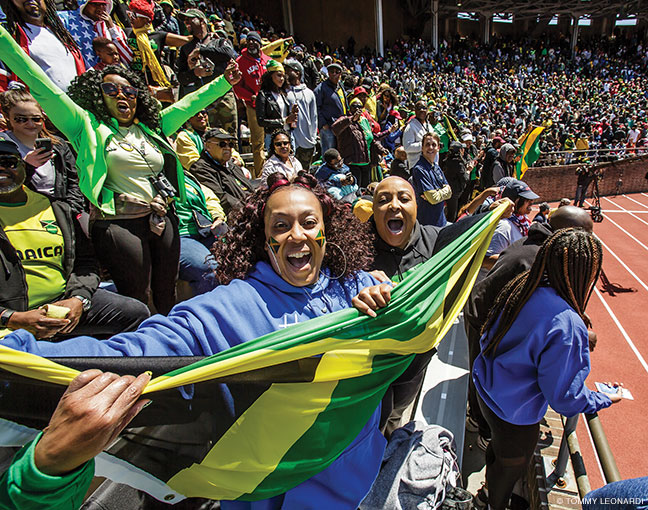
“Jamaican track fans are very, very intense,” Reid says, noting that the country’s airports are swarmed the entire week of Penn Relays. Many more come from the vast Jamaican diaspora of the Northeastern United States, sometimes waiting in a line that goes halfway down the South Street Bridge, just to watch, in person, sprinters from a country where track and field is the No. 1 sport. “It has become such an institution in Jamaica,” Reid says. “We call it Penns. Even people who have never been here, they talk about Penns.”
Jamaican high schools made their first appearance at Penn Relays in 1964, beginning a tradition in which the Caribbean sprinters could show off their speed in front of big crowds, set records, and sometimes even get scouted by American college coaches. But it wasn’t until 2000 that Jamaican fans could cheer for their country itself, rather than specific schools or athletes. That’s when the USA vs. the World races were launched, pitting professionals from different countries against each other and kickstarting what Reid calls a “good-natured rivalry” between Jamaica and the United States. (Those two track powerhouses usually take turns winning—but not always. At this year’s meet, Kenya surprisingly took first in the men’s sprint medley relay.)
Johnson is quick to point out that Olympians and world record holders raced at Penn Relays before the turn of the century—but in the late 1990s they were competing for shoe companies. “It was eerily quiet during some of those races,” he says. “Nobody cared if Nike beat Adidas or Reebok.” Johnson credits Craig Masback, the former CEO of USA Track & Field, and Nike executive John Capriotti, for the idea of putting athletes in their national team uniforms and beginning the USA vs. the World format, which this year celebrated its 20th anniversary.
Each of those 20 had its moments, from American track legend Michael Johnson among the Olympic Gold medalists running in the inaugural event, to Philly resident Raevyn Rogers anchoring USA to a win in this year’s women’s sprint medley relay a year after she and her teammates set a world record in the same event. But perhaps the best came in 2010 when Bolt came to Franklin Field to run for Jamaica. Bolt had competed in the Penn Relays as a high schooler, but this was his first appearance since winning the first three of his nine Olympic Gold medals (one of which has since been taken away due to a teammate’s doping disqualification), and the record crowd of 54,310 showered the superstar sprinter with love and appreciation. Not surprisingly, Bolt anchored Jamaica to a 4×100 victory with a meet-record time of 37.90 seconds. Somewhat more surprising, perhaps, was the incredible amount of noise that followed Bolt even as he walked into the stadium. “I had never heard that before,” Reid says, shaking his head at the memory.
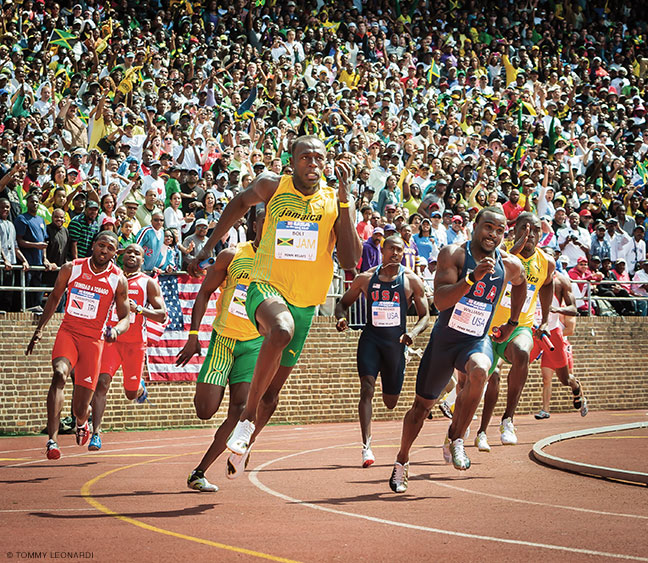
Everyone has their own Bolt memories. “People will forever say, ‘I was there the day Usain Bolt ran,’” Johnson says. That includes the high school and college athletes who brushed up against Bolt before or after his race. They then got to run in front of a crowd maybe 100 times bigger than what’s at their usual meets, as well as a national television audience. “Where else do you get that?” Johnson says.
The USA vs. the World spectacle does have detractors. According to Juliano, some of the “old-timers don’t really care for it” because they believe the presence of professionals “takes away thunder” from the amateurs. But high schoolers, college kids, Olympians, and even Masters runners all competing in the same two-hour window is one reason the Penn Relays remains a one-of-a-kind event. “It’s civilized chaos,” says Nehemiah, who stood on the infield Saturday afternoon while one 80-year-old walked right through a Team USA warm-up and a University of Indiana pole vaulter just inside the track ran practically in tandem with a Jamaican sprinter on the track. “It’s not a meet; it’s a carnival,” Reid says, pointing to long jump legend Bob Beamon standing in a crowded infield, just five yards from Penn athletic director M. Grace Calhoun and football coach Ray Priore. “In the United States,” Dolan adds, “to get this many people in one place celebrating the sport is amazing.”
The professionals who come to Penn Relays seem to enjoy the breadth of competitors at the carnival, too. Two members of Team USA, Kendra Chambers and Chris Giesting, also served as high school coaches for teams at the meet. Another, Michael Cherry, said he planned to walk around the “Carnival Village” outside of the stadium—where people gather to listen to music or eat turkey legs and funnel cake—to hand out USA Track gear, giving kids the same experience he had as a 16-year-old making his first Penn Relays appearance.
“It really puts it into perspective what we’re doing,” Giesting says. “Penn just has this mystique.”
Making It Run
The first thunder boom and lightning strike hit Friday morning, sending athletes and fans scrambling for cover in the concourse. “Oh, shit!” someone screamed as an official instructed them to clear the paddock (where athletes await their races, some vomiting from the nerves). It was a sentiment that Scott Ward, Penn’s senior associate athletic director/chief operations officer, might have shared in that moment.
Ward, who runs point for operations at Penn Relays, had been monitoring the weather since the crack of dawn, later admitting it was “a little bit stressful.” Lightning has delayed the Relays before, but it’s been exceedingly rare. This year it flashed in the morning and again in the afternoon, but everyone still got to run their races, some in the rain, with Friday’s slate ending a couple of hours later than usual.
By now, making the Penn Relays run might seem like old hat to Ward and several other longtime athletic administrators at the University. But the fact that the meet generally looks and feels like a well-oiled machine—even during driving thunderstorms, even through the challenges of being located on a city block as opposed to a sprawling complex like many other big stadiums—is a testament to the hard work that people put into it. “The trick is not to sit down. Otherwise you’re going to fall asleep,” says Ward, noting that he generally works from about 6 a.m. to 11 p.m. during Relays week. Some event coordinators crash on air mattresses in their offices each night.
The team effort extends beyond the operations and facilities people. Penn assistant football coach Steven Downs has acted as the unofficial Penn Relays bouncer at one of the entrances for many years. “You gotta get by him to be able to get in,” Ward says. “He’s the gatekeeper.” That can be a tough job, especially during the Saturday afternoon rush—or when someone tries to, um, sneak in a carton of eggs, as happened during the first day of this year’s meet.
Some years are more difficult than others. Extra security was needed when Joe Biden attended in 2015 to watch his nephew run, and also when the Penn Relays took place just 10 days after the Boston Marathon bombing in 2013. “We weren’t sure if it was an athletically targeted thing, or a track and field targeted thing,” says Chas Dorman, an associate director in athletic communications, recalling the nerve-wracking week preparing for that year’s meet. The late addition of Bolt in 2010 also presented challenges, with Penn getting twice as many media requests after the credential deadline had already passed. “We had to adjust everything, but that’s a great problem to have,” says Dorman, who teams with the rest of Penn’s athletic communications staff to run a media room of upwards of 300 journalists. “When you come to work here, you’re told what this means. To really see it in living color that day was inspiring.”
Dipen Shah C’00 was working as a student intern in the athletic communications office in the late 1990s when he was asked to help out with the Penn Relays’ website and alleviate the “ridiculously large” stacks of results that were printed out and passed around every year. “If you got a strong gust of wind, it was like, ‘Oh jeez,’” recalls Juliano. Shah was up to the task, “and kind of got hooked,” he says. He now runs his own digital technology consulting company specializing in track and field technology and has spent the last 20 years building a centralized online system to record schedules, registrations, results, event history, and more for Penn Relays. According to Shah, Johnson—who’s made a push to digitize the meet and build a “historic database that is accessible”—encouraged him to be creative and try new things. “Just don’t break the meet,” Shah recalls Johnson telling him. He didn’t. In fact, “over the years, we kind of developed the gold standard of results for meets like ours,” Shah says.
Shah is one of a select few people hired as a freelance contractor to work the meet. The vast majority of the 700 or so officials who pick up their red Penn Relays cap and descend upon Franklin Field are volunteers. Some, it’s been told, have it written into their employment contracts that they need to be off work the last Thursday and Friday of April. They are doctors, fashion designers, law professors, neurologists, school administrators, former track stars, CPAs, and NASA scientists—and those are just the Penn alums. They all have different jobs once they arrive, from organizing the chaotic paddock area to firing off the starters’ gun. But they all do it because they love the meet—and being around each other for a few days every spring.
“That’s the coolest thing,” Shah says. “It’s really not a track meet; it’s a once-a-year gathering of people who come together and put this show on for everyone. I think that’s the magic of the event.”
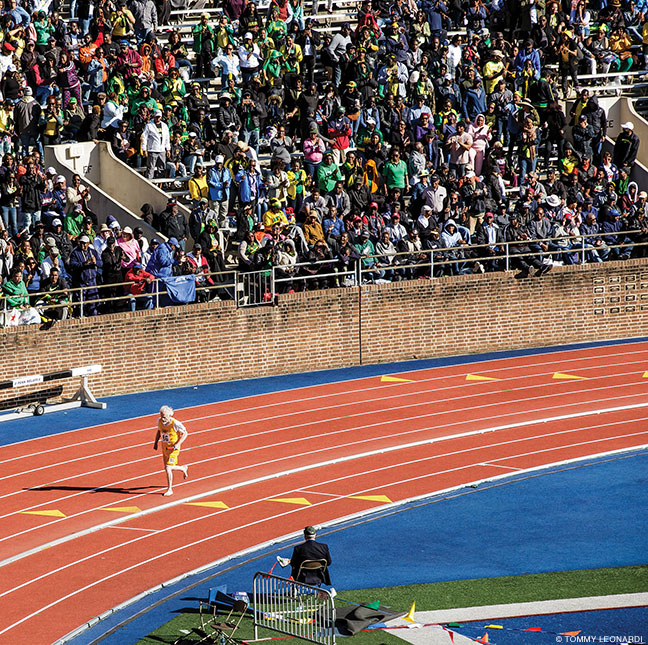
The Legacies
For the last 25 years, Joel Westman has had one of the more interesting—and frightening—jobs at Penn Relays. “I stand out on the field and have them throw eight-foot spears at me,” the javelin official says. “It revs up the adrenaline.”
His gold watch—a prize given to both Penn Relays champions and officials with 25 years of service under their belt—should have felt well-earned then. But just after the ceremony recognizing 25-year officials at this year’s meet, the presence of a couple of people on the infield humbled him. “I’m very proud to finally join my two sons,” Westman says, pointing to their watches. “They earned theirs. I just spent time here.”
One son, Ryan Westman, won his Penn Relays watch on a championship 4×400 team at Rutgers 15 years ago. The other, Max Westman C’09, captured the decathlon title for the Quakers 10 years ago—before posing for photos with the Franklin Field statue of former Penn football coach George Munger Ed’33, who had been the last Penn student to win the Penn Relays decathlon, all the way back in 1932.
The Westman family’s Penn Relays success is certainly quite an achievement, but plenty of others share their devotion to the meet. Jonas Harding started coming to Relays as a student at Philadelphia’s Central High School in the early 1950s, then kept coming as a coach at Overbrook High, and then came back for more as an official who trains other officials. “This is my last one, probably,” the 85-year-old says with a knowing smile. “But I’ve been saying that for 20 years.” The 2019 meet almost certainly won’t be the last one for Max Tucker, a high jump official, who says, “They’re never getting rid of me, man—until I can no longer walk.” That’s a sentiment Joel Westman agrees with—“as long as they don’t hit me with a spear,” he adds.
Steve Dolan was at his 27th consecutive Penn Relays this year, but the Penn track coach knows that’s “not a big number” compared to some of the officials who have been coming for as many as 60 straight years. Ed Grant might hold the current record at 74 straight meets, but the 92-year-old wouldn’t have been able to accomplish it without his son, who drives from Washington DC to northern New Jersey to bring him to Franklin Field every year (and who competed in the meet himself, for Georgetown, in the mid-1970s). So many others have passed their love for the Relays down, from generation to generation. That includes Cameron Burrell, who anchored one of the USA teams this year, almost 30 years after his father, Leroy, set world records on the same track. It also includes fans, who are known to have family reunions in the stands, meeting each other in the same section of the stadium year after year. “It’s just kind of magical, really, when you think about it,” Juliano says. “People come here as much for the camaraderie as they do the competition.”
As someone who inputs a lot of names into the system, Dipen Shah has a good vantage point on the “tradition passed down for generations of athletes who have run here.” He also can feel it miles away from Franklin Field, noting that if he’s wearing a Penn Relays shirt walking around Philly, “there’s a good chance someone stops me and says, ‘The Penn Relays! I ran in that!’” On campus, however, he believes students often don’t pay as much attention to the meet as they should. A healthy majority of the attendance—which, over the course of the three days, surpassed 110,000 this year for the 11th time—is made up of people from outside the Penn community. “I’ve always thought it’s one of the least recognized events on campus, especially for undergraduates, which is kind of a shame,” he says. “I think a lot of the student body misses out on seeing the magic of Franklin Field, the way it was.”
Johnson doesn’t push back on the claim of sparse student attendance but says it’s a “tough time” of year at the end of the semester and that, as exciting as the Penn Relays can be, track and field is still a niche sport in the US. “There aren’t a lot of track fans running around campus,” he says. “But I think if people come out, they see and feel the excitement, the energy. If you get them there once, you might have them for a long time.” Taking the long view, he also knows how the demographics of Penn Relays fandom has evolved over the years and may change again in the future. (For instance, before the Jamaicans made Franklin Field their home, African Americans flocked to support HBCU schools in the 1950s.) And regardless, the total numbers of tickets sold, combined with entry fees and sponsorship deals, is a revenue driver for the University. That wasn’t always the case, but Johnson says his Penn Relays director predecessor, Tim Baker, made a push to boost attendance while moving toward corporate sponsorships.
Johnson—who succeeded Baker in 1996 and is the first holder of the position since it was endowed as the Frank Dolson Director of Penn Relays (after the late sports writer and former Gazette contributor made a $1.2 million donation to the meet)—has continued to grow the event’s reach. The USA vs. the World format has ensured that the Saturday afternoon schedule has been aired on national television for the last 20 years. And this year he proudly orchestrated the 125th anniversary festivities, from a resolution at Philadelphia City Council, to the opening of a new photo exhibit at Hutchinson Gymnasium, to a Wall of Fame celebratory reception featuring USA Track legends Carl Lewis, Justin Gatlin, and Sanya Richards-Ross, among other Penn Relays stalwarts.
Looking ahead, Johnson is confident the Penn Relays will remain a significant part of the fabric of Philadelphia and Penn. So are many others. According to Dorman, “the University and the city have rekindled their affection for the meet” over the past decade. And for the people like him tasked with making it run, it’s an honor to sustain something that began in the 19th century—almost like they’re stepping back in time for a few days, hearing what it was like when Franklin Field was just opening or regularly full. “How could you have known when you’re having a couple of relay races between Harvard and Penn that 125 years later there’d be 50,000 people watching the elite of all time?” Dorman says. “Carrying this on is important to Dave—and everybody.”
When he first began the job, the overwhelming responsibility gnawed at Johnson. The night before a meet would be met with a feeling of dread. What if he forgot something? What if the 51 weeks preparing for one weekend turned out to be for naught? Quickly, though, he learned it “would be very difficult to screw this up, because nobody’s going to let you.” As the aging director contemplates both his own future and the future of what he believes to be the world’s largest annually contested meet, that same idea is a great source of comfort.
“All the volunteers, all the officials that come in, they’re not going to let it die,” Johnson says. “It’s also the coaches. It’s the athletes who have been brought up with this mystique: you’ve gotta run at Penn. It’s all the spectators who come back year after year after year. As much as we at Penn are the owners of the meet, the fact is, ultimately, we only succeed if we view ourselves as the conservators of a public trust.”
Put another way: “It belongs to everyone.”



